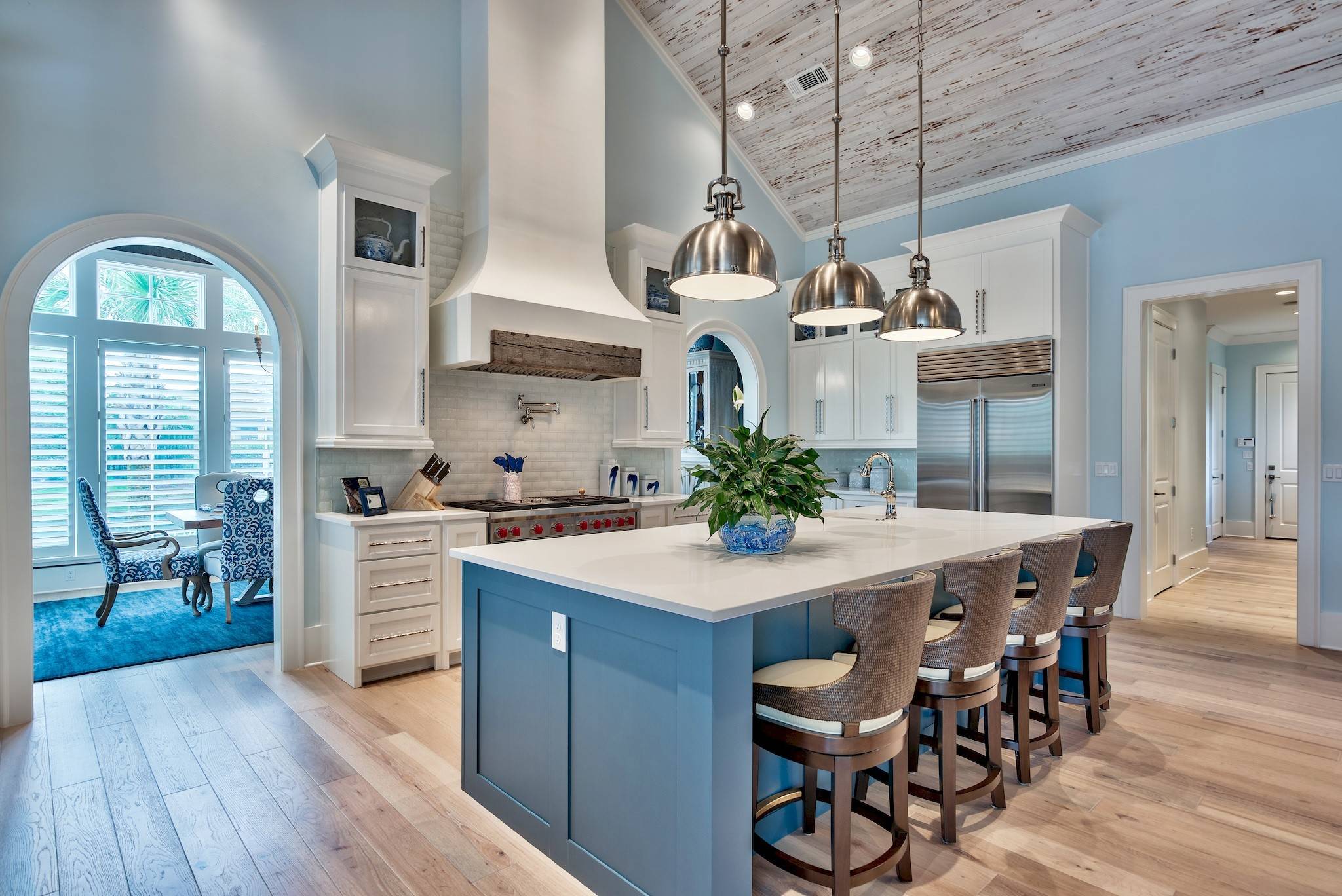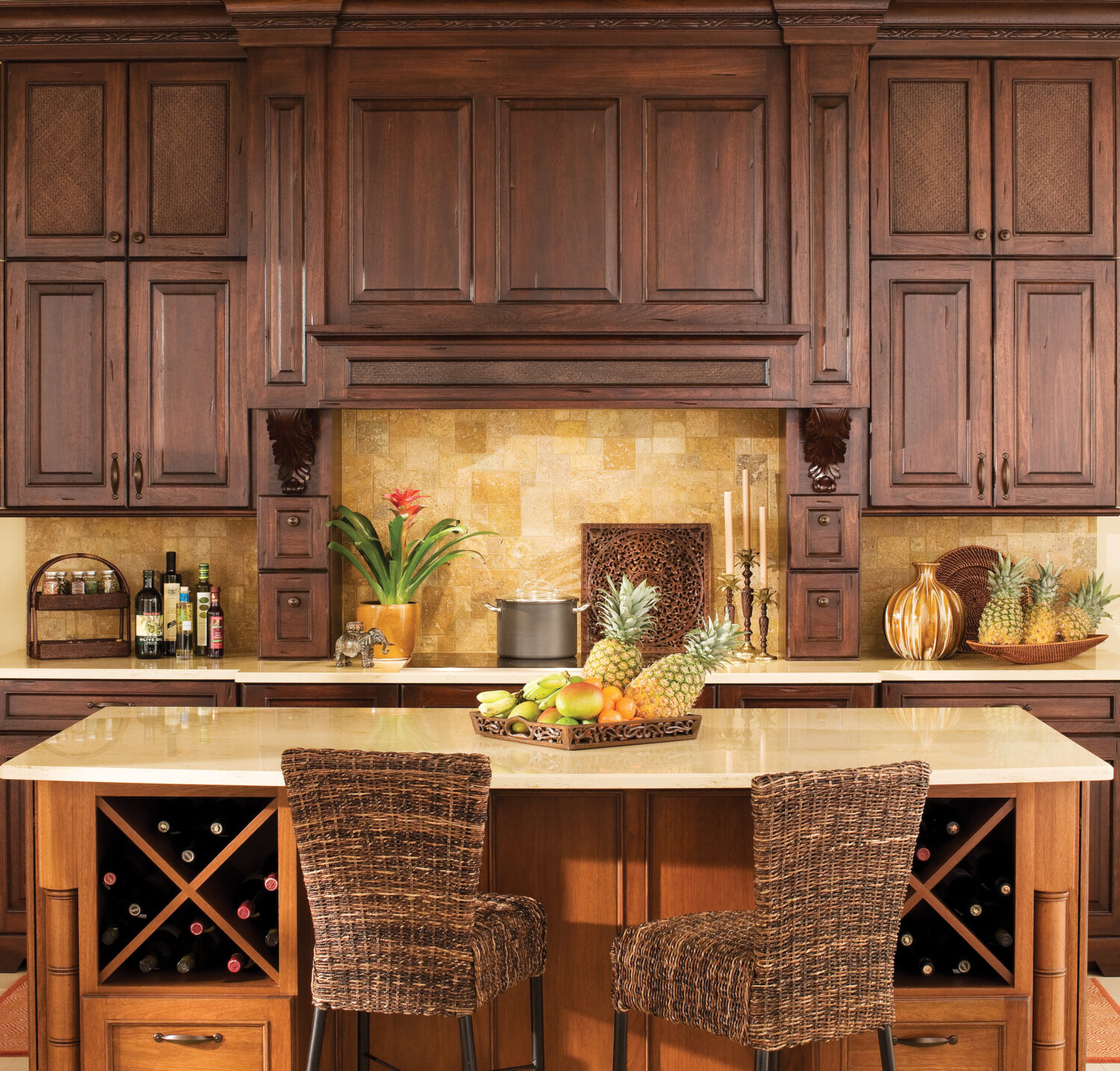Materials and Construction of Tropical Style Kitchen Cabinets

Tropical style kitchen cabinets evoke warmth and natural beauty, often utilizing materials and construction techniques that reflect their namesake regions. The choice of materials and construction methods significantly impacts the cabinets’ durability, maintenance requirements, and overall aesthetic. Understanding these factors is crucial for creating a kitchen that is both visually appealing and long-lasting.
Material Durability and Maintenance
The durability and maintenance requirements of tropical hardwoods vary considerably. Bamboo, a rapidly renewable resource, offers a lightweight yet surprisingly strong option. However, it requires regular sealing to protect against moisture damage and discoloration. Teak, renowned for its exceptional weather resistance and rich golden hue, demands minimal maintenance beyond occasional cleaning. Its natural oils provide inherent protection against rot and insect infestation. Mango wood, a byproduct of the mango fruit industry, presents a cost-effective alternative with a visually appealing grain pattern. It is relatively durable but requires regular sealing to prevent water damage and maintain its finish. Untreated mango wood is more susceptible to scratching and moisture damage than teak.
Cabinet Construction Methods
Two primary cabinet construction methods are commonly employed: frameless (European style) and face frame. Frameless cabinets feature sleek, minimalist designs, maximizing storage space. Their suitability for tropical styles depends on the chosen materials; hardwoods are more appropriate than particleboard in humid climates. Face frame cabinets, featuring a visible frame around each cabinet door, offer increased structural rigidity. This makes them a robust choice for heavier doors and drawers, particularly advantageous when using denser tropical hardwoods. The added structural support is beneficial in environments with fluctuating humidity levels, common in tropical regions.
Example Tropical Style Kitchen Cabinet Design, Tropical style kitchen cabinets
Consider a custom-designed island unit measuring 96 inches long, 36 inches wide, and 36 inches high. The cabinet is constructed using a face frame method with solid teak wood for the frame and doors. The cabinet doors are paneled with mango wood, creating a visually striking contrast. The countertop is a durable quartz surface, chosen for its resistance to heat, stains, and moisture. The construction utilizes mortise and tenon joinery for superior strength and stability.
Image Description: The image depicts the island unit. The rich, golden-brown hue of the teak frame provides a warm backdrop for the lighter, more textured mango wood panels. The grain patterns of both woods are clearly visible, adding to the natural aesthetic. The smooth, cool quartz countertop contrasts beautifully with the warm tones of the wood. The overall impression is one of sophisticated rusticity, characteristic of a high-end tropical kitchen design.
Cost-Effectiveness of Solid Wood vs. Engineered Wood
The decision between solid wood and engineered wood significantly impacts the cost of tropical style kitchen cabinets.
- Solid Wood: Higher initial cost due to material sourcing and labor-intensive construction. However, it offers superior durability, longevity, and potential for refinishing, leading to lower long-term costs. Solid wood cabinets can significantly increase a home’s resale value.
- Engineered Wood: Lower initial cost, making it a budget-friendly option. However, it is less durable than solid wood and may not withstand the humidity and temperature fluctuations of tropical climates as effectively. Refinishing is often limited, potentially leading to higher replacement costs in the long run.
Integrating Tropical Style Kitchen Cabinets into Different Kitchen Designs

The inherent versatility of tropical-style kitchen cabinets allows for seamless integration into a variety of kitchen design aesthetics, creating unique and visually appealing spaces. Their warm tones and natural materials offer a contrasting yet complementary element when paired with modern or farmhouse styles. Careful consideration of color palettes, countertop choices, and lighting schemes is crucial for achieving a balanced and harmonious design.
Tropical Style Cabinets in Modern Kitchens
Modern kitchens, often characterized by clean lines, minimalist designs, and a neutral color palette, can benefit from the injection of warmth and texture provided by tropical-style cabinets. The contrast between the sleek, often metallic or glass-heavy elements of a modern kitchen and the rich wood grains and possibly vibrant colors of tropical cabinets creates a visually striking juxtaposition. To maintain balance, consider using a lighter-toned wood for the cabinets, perhaps with subtle distressing to avoid overwhelming the minimalist aesthetic. Pairing these cabinets with stainless steel appliances and simple, unfussy countertops, such as white quartz or concrete, reinforces the modern feel while allowing the tropical cabinets to act as a focal point. The overall effect should be one of sophisticated contrast, where the natural warmth of the wood complements the cool tones of the modern elements.
Tropical Style Cabinets in Farmhouse Kitchens
The integration of tropical-style cabinets into a farmhouse kitchen creates a unique blend of rustic charm and tropical warmth. Farmhouse kitchens typically feature light, airy spaces with a focus on natural materials. Tropical cabinets, particularly those with lighter wood tones and subtle distressing, can enhance this aesthetic. The natural wood complements the often-used reclaimed wood or painted surfaces found in farmhouse designs. The warmth of the tropical wood can soften the often stark white or light-colored walls and cabinetry common in farmhouse kitchens, creating a more inviting and comfortable space. Consider incorporating other natural elements, such as woven baskets or greenery, to further emphasize the synergy between the tropical and farmhouse styles. The use of open shelving, another common farmhouse feature, can also display beautiful tropical-themed decorative items, reinforcing the overall design concept.
Lighting to Enhance Tropical Kitchen Aesthetics
Lighting plays a pivotal role in highlighting the unique characteristics of tropical-style kitchen cabinets and creating the desired ambiance. Pendant lights, particularly those with woven shades or natural materials like bamboo, can mimic the natural light filtering through a tropical canopy, casting warm, inviting light over the cabinetry. Recessed lighting, used strategically, can provide task lighting for work areas while simultaneously highlighting the texture and grain of the wood. Warm-toned LED bulbs are ideal for enhancing the richness of the wood tones and creating a cozy, inviting atmosphere. Avoiding harsh, bright white lighting is essential; instead, opt for warmer color temperatures to evoke the feeling of a sun-drenched tropical environment. A well-lit space allows the natural beauty of the wood grain and any decorative elements to shine, contributing to the overall tropical aesthetic. The interplay of light and shadow further enhances the depth and texture of the cabinets, creating a visually appealing and inviting space.
